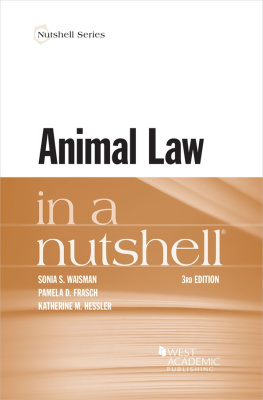Dedication
For William Maugham, who encouraged me to read.
Let Us Now Praise Infamous Animals by Jeffrey St. Clair
In the spring of 1457, a gruesome murder took place in the French village of Savigny-sur-Etang. A five-year-old boy had been killed and his body partially consumed. A local family was accused of this frightful crime by local residents who claimed to have witnessed the murder. The seven suspects, a mother and her six children, were soon tracked down by local authorities, who discovered them still stained by the boys blood. They were arrested, indicted on charges of infanticide and held in the local jail for trial.
The defendants were indigent and the court appointed a lawyer to represent them. A few weeks later a trial was convened in Savignys seigneurial court. Before a crowded room, witnesses were called. Evidence was presented and legal arguments hotly debated. The justices considered the facts and the law and rendered a verdict and a sentence. The mother was pronounced guilty and ordered to be hanged to death by her legs from the limb of the gallows tree. Her six children, however, received a judicial pardon. The court accepted the defense lawyers argument that the youngsters lacked the mental competence to have committed a crime in the eyes of the law. The orphaned children were sent into custodial care at the expense of the state.
This is an interesting case to be sure, featuring important lessons about the legal rights of the poor and the historic roots of juvenile justice in western jurisprudence, lessons that seem entirely lost on our current tradition-obsessed Supreme Court. But heres the kicker: the defendants in these proceedings were not members of our species. They were, it must be said, a family of pigs.
The Savigny murder case, even in its ghastly particulars, was unexceptional. In medieval Europe (and even colonial America) thousands of animals were summoned to court and put on trial for a variety of offenses, ranging from trespassing, thievery and vandalism to rape, assault and murder. The defendants included cats, dogs, cows, sheep, goats, slugs, swallows, oxen, horses, mules, donkeys, pigs, wolves, bears, bees, weevils, and termites. These tribunals were not show trials or strange festivals like Fools Day. The tribunals were taken seriously by both the courts and the community.
Though now largely lost to history, these trials followed the same convoluted rules of legal procedure used in cases involving humans. Indeed, as detailed in E. P. Evanss remarkable book, The Criminal Prosecution and Capital Punishment of Animals (1906), humans and animals were frequently tried together in the same courtroom as co-conspirators, especially in cases of bestiality. The animal defendants were appointed their own lawyers at public expense. Animals enjoyed appeal rights and there are several instances when convictions were overturned and sentences reduced or commuted entirely. Sometimes, particularly in cases involving pigs, the animal defendants were dressed in human clothes during court proceedings and at executions.
Animal trials were held in two distinct settings: ecclesiastical courts and secular courts. Ecclesiastical courts were the venue of choice for cases involving the destruction of public resources, such as crops, or in crimes involving the corruption of public morals, such as witchcraft or sexual congress between humans and beasts. The secular and royal courts claimed jurisdiction over cases where animals were accused of causing bodily harm or death to humans or, in some instances, other animals.
When guilty verdicts were issued and a death sentence imposed, a professional executioner was commissioned for the lethal task. Animals were subjected to the same ghastly forms of torture and execution as were condemned humans. Convicted animals were lashed, put to the rack, hanged, beheaded, burned at the stake, buried alive, stoned to death and drawn-and-quartered. In 14 th century Sardinia, trespassing livestock had an ear cut-off for each offense. In an early application of the three-strikes-and-youre-out rule, the third conviction resulted in immediate execution.
The flesh of executed animals was never eaten. Instead, the corpses of the condemned were either burned, dumped in rivers or buried next to human convicts in graveyards set aside for criminals and heretics. The heads of the condemned, especially in cases of bestiality, were often displayed on pikes in the town square adjacent to the heads of their human co-conspirators.
The first recorded murder trial involving an animal took place in 1266 at Fontenay-aux-Roses (birthplace of the painter Pierre Bonnard) on the outskirts of Paris. The case involved a murder of an infant girl. The defendant was a pig. Though the records have been lost, similar trials almost certainly date back to classical Greece, where, according to Aristotle, secular trials of animals were regularly held in the great Prytaneum of Athens.
Interestingly, Thomas Aquinass Summa Theologiae, written in 1269, is in part an attack on Aristotles ideas and his radical acolytes who had infiltrated the universities of thirteenth century Europe. In the Summa, Aquinas laboriously tried to explain the theological basis for the trials of animals.
While most of the animal trials, according the records unearthed by Evans, appear to have taken place in France, Germany and Italy, nearly every country in Europe seems to have put beasts on trial, including Russia, Poland, Romania, Spain, Scotland and Ireland. Anglophiles have long claimed that England alone resisted the idea of hauling cows, dogs and pigs before the royal courts. But Shakespeare suggests otherwise. In The Merchant of Venice, Portias friend, the young and impetuous Gratiano, abuses Shylock, comparing him to a wolf that had been tried and hanged for murder:
Thy currish spirit
Governd a wolf, who, hangd for human slaughter,
Even from the gallows did his fell soul fleet,
And, whilst thou layst in thy unhallowd dam,
Infusd itself in thee..
Even colonial Brazil got in on the act. In 1713 a rectory at the Franciscan monastery in Piedade no Maranho collapsed, its foundation ravaged by termites. The friars lodged charges against the termites and an ecclesiastical inquest soon issued a summons demanding that the ravenous insects appear before the court to confront the allegations against their conduct. Often in such cases, the animals who failed to heed the warrant were summarily convicted in default judgments. But these termites had a crafty lawyer. He argued that the termites were industrious creatures, worked hard and enjoyed a God-given right to feed themselves. Moreover, the lawyer declared, the slothful habits of the friars had likely contributed to the disrepair of the monastery. The monks, the defense lawyer argued, were merely using the local termite community as an excuse for their own negligence. The judge returned to his chambers, contemplated the facts presented him and returned with a Solomonic ruling. The friars were compelled to provide a woodpile for the termites to dine at and the insects were commanded to leave the monastery and confine their eating to their new feedlot.
A similar case unfolded in the province of Savoy, France in 1575. The weevils of Saint Julien, a tiny hamlet in the Rhone Alps, were indicted for the crime of destroying the famous vineyards on the flanks of Mount Cenis. A lawyer, Pierre Rembaud, was appointed as defense counsel for the accused. Rembaud wasted no time in filing a motion for summary judgment, arguing that the weevils had every right to consume the grape leaves. Indeed, Rembaud asserted, the weevils enjoyed a prior claim to the vegetation on Mount Cenis, since, as detailed in the Book of Genesis, the Supreme Deity had created animals before he fashioned humans and God had promised animals all of the grasses, leaves and green herbs for their sustenance. Rembauds argument stumped the court. As the judges deliberated, the villagers of Saint Julien seemed swayed by the lawyers legal reasoning. Perhaps the bugs had legitimate grievances. The townsfolk scrambled to set aside a patch of open land away from the vineyards as a foraging ground for the weevils. The land was surveyed. Deeds were drawn up and the property was shown to counselor Rembaud for his inspection and approval. They called the weevil reserve La Grand Feisse. Rembaud walked the site, investigating the plant communities with the eyes of a seasoned botanist. Finally, he shook his head. No deal. The land was rocky and had obviously been overgrazed for decades. La Grand Feisse was wholly unsuitable for the discriminating palates of his clients. If only John Walker Lindh had been appointed so resolute an advocate!














